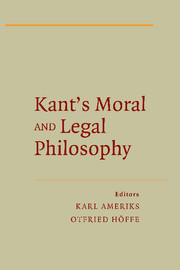Book contents
- Frontmatter
- Contents
- ACKNOWLEDGMENTS
- CONTRIBUTORS
- WORKS BY KANT
- Introduction
- I EARLY CONCEPTIONS
- II GROUNDWORK OF THE METAPHYSICS OF MORALS
- III CRITIQUE OF PRACTICAL REASON
- IV LEGAL AND POLITICAL PHILOSOPHY
- 11 On How to Acquire Something External, and Especially on the Right to Things (A Commentary on the Metaphysics of Morals §§10–17)
- 12 ‘The Civil Constitution in Every State Shall Be a Republican One’
- 13 Commentary on Kant's Treatment of Constitutional Right (Metaphysics of Morals II: General Remark A; §§51–52, Conclusion, Appendix)
- 14 Refusing Sovereign Power – The Relation between Philosophy and Politics in the Modern Age
- BIBLIOGRAPHY
- INDEX
13 - Commentary on Kant's Treatment of Constitutional Right (Metaphysics of Morals II: General Remark A; §§51–52, Conclusion, Appendix)
Published online by Cambridge University Press: 13 November 2009
- Frontmatter
- Contents
- ACKNOWLEDGMENTS
- CONTRIBUTORS
- WORKS BY KANT
- Introduction
- I EARLY CONCEPTIONS
- II GROUNDWORK OF THE METAPHYSICS OF MORALS
- III CRITIQUE OF PRACTICAL REASON
- IV LEGAL AND POLITICAL PHILOSOPHY
- 11 On How to Acquire Something External, and Especially on the Right to Things (A Commentary on the Metaphysics of Morals §§10–17)
- 12 ‘The Civil Constitution in Every State Shall Be a Republican One’
- 13 Commentary on Kant's Treatment of Constitutional Right (Metaphysics of Morals II: General Remark A; §§51–52, Conclusion, Appendix)
- 14 Refusing Sovereign Power – The Relation between Philosophy and Politics in the Modern Age
- BIBLIOGRAPHY
- INDEX
Summary
It is only in §51 (6:338) of the Metaphysics of Morals – that is, in the second half of the discussion of ‘Constitutional Right’ – that Kant introduces a distinction that is fundamental to his exposition of the theory of the state. For here Kant distinguishes between the ‘pure idea of a head of state,’ which is already implied in the concept of a commonwealth as such (res publica latius dicta) and enjoys ‘objective practical reality,’ and a ‘physical person’ who is ‘to represent the supreme authority in the state and to make this idea effective on the people's will’. In the preceding sections, §§45–49, he has already introduced ‘the state in idea,’ the state ‘as it ought to be in accordance with pure principles of right’ and that essentially serves as a ‘norm’ (norma) (§45; 6:313) for every commonwealth. In the remaining sections (§§51–52). Kant proceeds to discuss the various forms in which the political authority is expressed in and as a ‘physical’ head of state.
But it is only in the succeeding year that Kant explicitly develops the conceptual distinction that underlies the architectonic framework of his earlier discussion. And this is the contrast between a ‘respublica noumenon’ and a ‘respublica phaenomenon,’ which Kant presents in The Conflict of the Faculties.
- Type
- Chapter
- Information
- Kant's Moral and Legal Philosophy , pp. 265 - 283Publisher: Cambridge University PressPrint publication year: 2009
- 2
- Cited by

